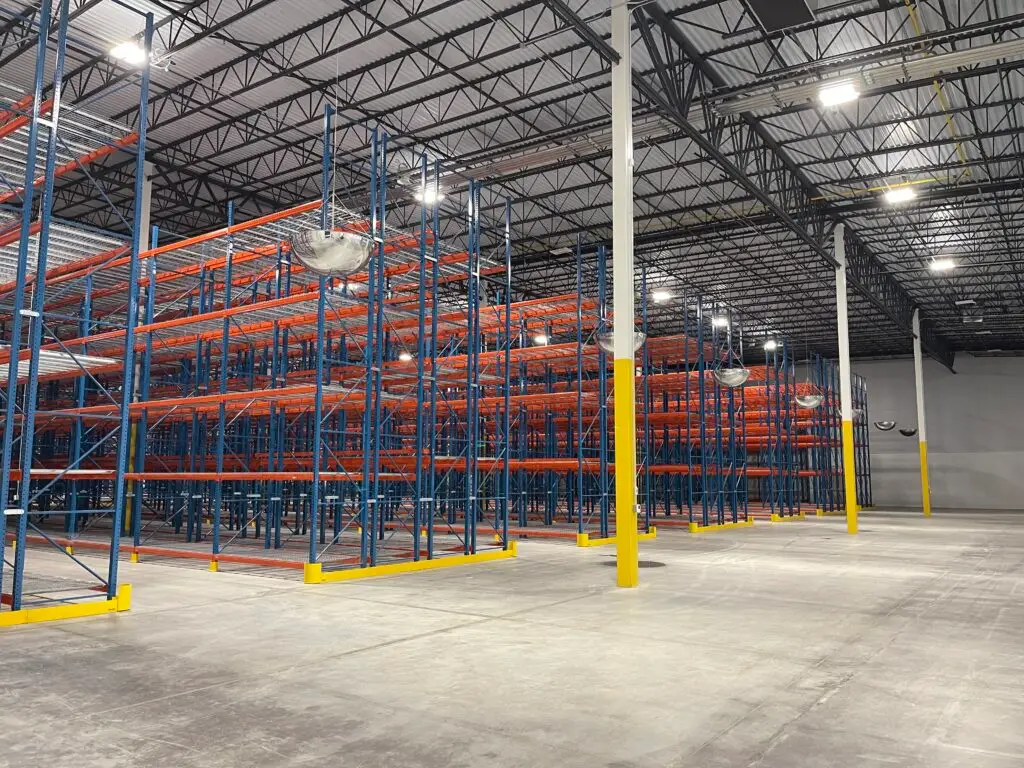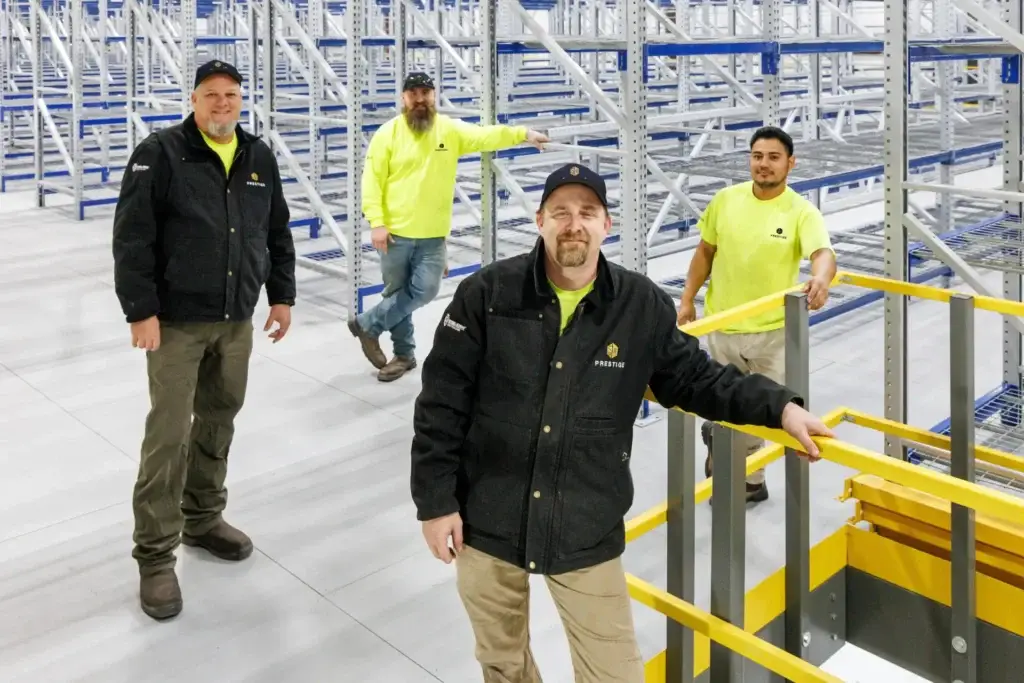Traditional Warehouse Storage

Enhancing Supply Chains with Traditional Storage
Maximizing Efficiency with Proven Storage Solutions
In today’s fast-paced business environment, efficient supply chain management is crucial for success. Traditional warehouse storage refers to the conventional methods and systems used to store, organize, and manage inventory within traditional warehouses or distribution centers. These methods have been refined over decades, forming the backbone of many successful supply chain operations. While advanced technologies can steal the spotlight, traditional warehouse storage methods continue to play a vital role in revolutionizing supply chains. Prestige is equipped to explore the transformative power of storage solutions in boosting operational efficiency and driving growth.
Key Components of Traditional Storage Systems
Traditional storage systems form the foundation of efficient inventory management and space utilization. Prestige offers a range of time-tested storage solutions that can be tailored to meet your business's unique needs:
- Racking Systems: Racking systems offer efficient vertical storage for palletized goods and various inventory types. Prestige provides a range of options, including selective racking for immediate access to every pallet, ideal for operations with numerous stock keeping units (SKUs). We also offer dense racking systems for maximized storage capacity with low SKU count inventory. Our expertise extends to specialty racking solutions such as cantilever racks for long or irregularly shaped items, and die storage racks for heavy dies and molds.
- Shelving and Cabinets: Perfect for smaller items or broken-case picking, our shelving and cabinet solutions provide versatility and easy access to stored products. Prestige offers industrial open/closed shelving, modular drawer cabinets for high-density storage of small to medium-sized items, and bin shelving for economical storage of small parts and tools. Our modular drawer cabinets can reduce storage footprint by up to 50% while providing 100% visibility and access to stored products.
- Lockers: Prestige supplies a variety of locker solutions to meet diverse storage needs. We stock metal lockers in 34 standard premier color options, with custom colors available to match specific applications. For environments requiring moisture resistance and durability, we offer phenolic/plastic lockers made from HDPE material. Our high-end wood lockers are crafted from various wood types for a luxurious storage solution.
- Bins and Accessories: To complement our storage systems, Prestige offers a wide range of bins and accessories. Our selection includes high-density storage bins, nest & stack totes, robust bins for bulky items, and multi-compartment bins for streamlined organization. We also provide clear bins for enhanced visibility of contents. To maximize organization and efficiency, we offer accessories such as clear lids, dividers, inserts, rail kits, and labeling solutions, all compatible with our bins, totes, and shelving products.
Unlock the potential of your storage space – Contact our team for a free consultation!
The Advantages of Traditional Storage Methods
Traditional storage methods continue to offer significant advantages for warehouses of all sizes. These time-tested solutions balance cost-effectiveness, flexibility, and reliability, which many businesses find invaluable. Some key benefits that make traditional storage methods a compelling choice for optimizing warehouse operations include:
- Cost-Effectiveness: Traditional storage systems generally require lower initial investment than automated alternatives.
- Flexibility: These systems can be easily reconfigured or expanded to accommodate changing inventory needs.
- Simplicity: With minimal training required, traditional methods are often easier for staff to understand and implement.
- Reliability: Time-tested solutions offer proven reliability with fewer technical issues than complex automated systems.
- Customization: Traditional storage can be tailored to fit unique product dimensions and warehouse layouts.
Challenges and Considerations
Enhancing Efficiency and Precision
While traditional storage methods offer numerous benefits, they also present some challenges:
- Labor Intensity: Manual handling and retrieval can be time-consuming and physically demanding.
- Space Utilization: Traditional methods may not maximize vertical space as efficiently as some automated systems without careful planning.
- Inventory Accuracy: Manual processes can be prone to human error, potentially affecting inventory accuracy.
- Scalability: As operations grow, traditional systems may struggle to keep pace with increasing throughput demands.
By leveraging these time-tested methods and combining them with modern management techniques, businesses can revolutionize their supply chains without requiring extensive capital investment in automation. Traditional storage methods continue to offer a reliable, flexible, and cost-effective foundation for efficient warehouse supply chain operations.

Behind the Shelving
The Team Driving Your Storage Success
At Prestige, we are passionate about revolutionizing warehouse storage and material handling solutions. Since our founding in 1970, we have been at the forefront of providing innovative, efficient, and customized storage solutions for businesses across various industries.
Our team of experts brings decades of experience in traditional storage methods, space transformation, and automated systems. We pride ourselves on blending time-tested storage techniques with cutting-edge technology, offering our clients the best of both worlds.
Whether you re looking to streamline your existing storage systems or completely transform your warehouse space, Prestige is your trusted partner. Were not just about selling products; we’re about providing comprehensive solutions that address your unique challenges and help your business thrive.
Join the thousands of satisfied clients who have experienced the Prestige difference. Let us help you unlock the full potential of your warehouse space and revolutionize your supply chain.
FAQ
Commonly Asked Questions
What is the most efficient traditional warehouse storage method?
The most efficient traditional warehouse storage depends on specific operational needs, but selective pallet racking is often considered efficient for many warehouses. This system offers direct access to all pallets, accommodates various product sizes, and allows for easy stock rotation. Its versatility makes it suitable for a wide range of industries and inventory types. When combined with a well-designed layout and an efficient warehouse management system, selective pallet racking can significantly enhance productivity and space utilization.
How can I maximize space in my warehouse using traditional storage methods?
Maximizing space in your warehouse using traditional storage methods involves a multifaceted approach. Start by laying out your storage system effectively, taking into consideration height, width, and depth of a facility. Optimizing across these constraints can dramatically increase storage capacity without expanding your warehouse’s footprint. If you are using traditional selective rack with typical aisles, consider a dense system solution. Consider installing mezzanines or industrial work platforms to create additional floor space, effectively doubling or even tripling your usable area. Finally, optimize product slotting based on size, weight, and order fulfillment frequency to efficiently use available space and streamline operations. Remember, the key to maximizing space is carefully analyzing your specific inventory needs and warehouse flow to determine the best combination of these methods.
What are the key differences between traditional and automated warehouse storage?
Traditional and automated warehouse storage systems differ in several key aspects. Traditional systems typically have lower upfront costs, making them more accessible to businesses of various sizes. They also offer greater flexibility and adaptability to changing inventory needs or warehouse layouts. Automated systems, on the other hand, often provide faster and more precise operations, reducing human error and potentially increasing throughput. They usually require less manual labor but come with higher initial costs and may be less flexible to changing needs. The choice between traditional and automated storage ultimately depends on factors such as budget, operational volume, labor availability, and long-term business goals.
